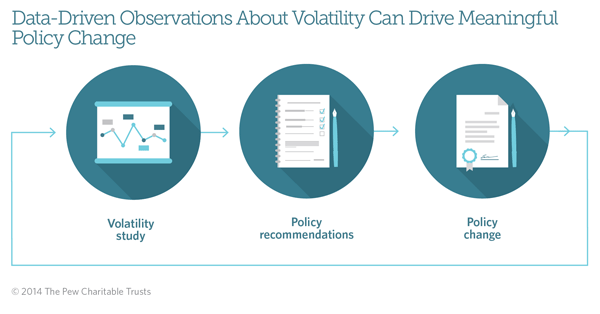In Utah, Evidence-based Policies for Rainy Day Funds
Utah is a national leader in long-term fiscal management. Legislation enacted in April 2014 further strengthens the state's work to understand and mitigate revenue volatility, which is a key element in the prudent stewardship of finances.
In 2008, Utah implemented regular analyses of revenue volatility, becoming the only state with a statutory requirement to produce such studies on a recurring basis. These analyses, released every three years, provide lawmakers with data-driven observations about volatility and how it contributes to overall budget uncertainty, which then inform important policy decisions. Utah's studies include all of the critical components of well- designed volatility reports, including:
- Measurement of the volatility of all major revenue streams.
- Identification of the key factors influencing volatility.
- Analysis of historical trends and future projections of volatility drivers.
- Discussion of how those trends affect long-term volatility.
- Clear policy recommendations for rainy day fund design to mitigate future volatility and build an adequate financial cushion during times of growth.
Since the studies were implemented, Utah policymakers have used the findings to inform rainy day fund policies, increasing the limits on its two budget reserve funds twice since 2008—in 2009 and 2012—to ensure savings were in line with observed levels of volatility. The state also added a provision to its study, taking steps to track volatility in the federal funds it receives along with its own-source revenue.

The measure expands the volatility study to consider automatic-deposit mechanisms for the budget reserve funds. As a result of this legislation, Utah policymakers will have the information they need to design an effective deposit mechanism and potentially join 12 other states that automatically set aside revenue during periods of growth into savings for use in future downturns.1
Other states can learn from Utah's experience and improve their fiscal management by studying revenue volatility and adjusting rainy day fund policies. Together these valuable tools can help states weather the ups and downs of the economic cycle.
Endnote
1 The 12 states that have rules requiring deposits in times of growth, particularly above-trend increases, in certain volatile tax sources or based upon the performance of their economies, include Alaska, Arizona, Hawaii, Idaho, Indiana, Louisiana, Massachusetts, Michigan, Tennessee, Texas, Virginia, and Washington.






